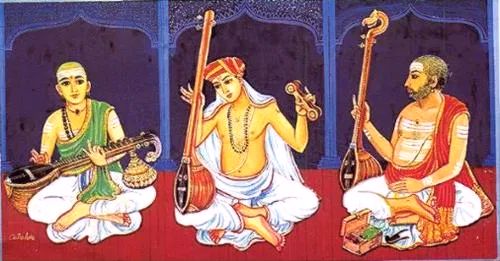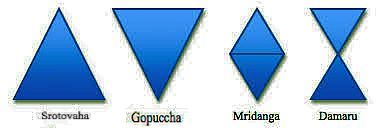Sri Shyama Shastry – Music-Continued

Svarajati
Svarajati, as the name suggests, is a combination of Svaras (notes) and Jati (rhythmic pattern represented by a vocal ‘Sol’).
The Svarajati is said to have been developed in two ways – one type with Jatis to suit dance movements; and, the other, a simple type for beginners in music.
Thus, the Svarajati could be rendered as a song, with all the Alamkaras; and, it could also be a musical composition adorned with graceful and flowing stream of rhythms, to which a Dancer performs with apt Nrtta (rhythmic-body-movements) ; and , presenst the interpretation of its words through Abhinaya (meaningful expressions).
The main features of the Svarajatis are (1) presence of a number of Svara-Sahitya passages in the Carana ;( 2) the absence of Anupallavi; and, (3) preponderance of Jatis
The first two features can be seen in beginner’s Svarajatis. And, in the Dance-Svarajatis, the third factor is important.
*
As regards the Svarajatis, which belonged to the sphere of Abhyasa-gana; they were mainly intended to be learnt by students of music. These were simpler types, without the Jatis.
On account of the simple, yet qualitative music, and good rhythmic flow, many Svarajatis are taught to the students of music, after they learnt Gitas; but, before the Varnas. The Svarajatis are, therefore, normally treated as Abhyasa-gana class of practical compositions.
[Simpler Svarajatis, without Jatis and the Anga of Muktayi Svara, were composed for the benefit of students of art music and dance. These are pieces to be learnt after a course in Alankara, Gita and Jatisvara; but, before learning to sing Varnas.
The purpose of learning Jatisvara and Svarajati is to get a good grasp of the rhythm, which would prepare the student for the next difficult piece, the Varna.
Thus, there is some logic behind the graded method of teaching the musical forms.
The Sahitya of a Svarajati has more words than the Sahitya of a Gita.
To enable the student to get familiar with a Sahitya consisting of more number of words; to train her/him to sing properly, following the time-units precisely is perhaps the intention behind the gradation of these technical forms.]
This Abhyasa-gana type of Svarajatis is quite different from the Pada-Varna. It has a different structure. It has no Anupallavi; but, there is coordination between the Svaras and the syllables of the Sahitya. The Sahitya and the melody take priority.
Perhaps, the only common point it has with the Pada-Varna is the fact that the beginning Svara sahitya passages are simpler; and, there is a gradual increase in the length and complexity of the lines.
*
As regards the Svarajatis that are specially designed for Dance; they have rhythmic syllables or Sollukottus in its musical structure. In this type, there are Jatis and Sahitya for all the Svara-passages. The Svara and Sahitya lines which follow each other alternatively, lend themselves well to the Abhinaya and Nrtta sequences in a dance.
Here, the Nrtta (rhythmic-body-movements) and Adavus (basic steps in Dance) are performed to the Svaras and Sollokottu; whereas, the Abhinaya is performed to the Sahitya.
The early version of the Dance-Svarajatis resembled the Pada-Varnas. It had a short Pallavi, Anupallavi and a fairly long Carana portion, consisting of Carana-Sahitya, Svara passages and a Jati section.
*
The third type of Svarajati, which has no Jati or Sollukottu in its structure; which has the refinement to project the Raga-svarupa; and, which can be rendered in music concerts, was the one that was developed by Sri Shyama Shastry.
The Svarajatis developed by Sri Shyama Shastry are far more advanced and sophisticated than the simple Abhyasa-gana Svarajatis. And, at the same time, they are different from the Dance Svarajatis.
The Svarajatis of Sri Shyama Shastry form a separate class of compositions, which do not resemble Dance-Svarajatis. They do not have a Mukthayi-Svara section with Sahitya and Jati. They also do not, generally, form a part of the repertoire of Dance-Music. They are largely rendered in Art-musical-concerts.
In their structure, these types of Svarajatis are made of Pallavi, and many Caranas in the form of Svara-Sahityas (Svara syllable having a corresponding syllable of text of identical duration).
A number of Svara-Sahitya passages in the Carana and the absence of Anupallavi are the other characteristic features of this type of Svarajati.
The Svarakshara beauty, where the syllable of the text is identical or similar to the correspondent Svara syllable, is a noteworthy feature in most of the Svarajatis.
Svara-Sahitya is a combination of Svara (Sol-fa) passages with appropriate Sahitya passages that match the Svaras. The Svara-part should steadily maintain continuity with the Music of the Sahitya of the Carana; and, should methodically lead to the Pallavi. Again, the Sahitya-portion of the Svara-Sahitya should blend with the Sahitya of the Carana; and, later with the Carana.
That is to say; the Svarajatis are compositions made of Pallavi, Anupallavi and Caranas in the form of Svara-sahitya. Now, while rendering the Carana, its Svaras are sung first; and, then its corresponding Sahitya is presented. After the final Carana, the Pallavi is again rendered as the conclusion.
By increasing the numbers of Svara letters and the Sahitya letters, according to the time-units of the Taala-aksharas, the Carana-Svaras are sung as if in Madhyama-kala. The number of Avartas (one Avarta is a complete cycle of a Taala) for the Carana-Svaras is also increased gradually.
When one tries to explain in words, it does sound very complicated. But, when an erudite artist sings, seamlessly weaving the Svara-Sahitya passages with consummate skill and artistry, it is truly delightful.

Almost running parallel to what I said above:
Dr. Ritha Rajan, in her article ‘Jatisvaram/Svarajati’ published in the Journal of the Music Academy Madras (Vol. LXXV- 2002) mentions that Sri Subbarama Dikshitar, in his Sangita-Sampradaya-Pradarshini, described two types of Svarajatis.
The first type of Svarajatis are those, which are more suitable for Dance-Dramas , like Bhagavatha-Mela-Natakas, wherein the brisk Madhyama–Kala could be executed , with all its vigour and gusto, by the male dancers.
This is said to be the older form or type of Svarajati; with Madhyama-kala as its characteristic feature. Many of them are set in Tisra-Eka-Taala (each unit of Taala being three melodic pulses) or in Rupaka-Taala (one Dhruta followed by one Laghu).
The Mukthayi (a passage of Svara syllables that succeeds an Anupallavi, usually of two Avartas) was composed with the first phase, with only long Svaras; the second phase in Madhyama-kala; and, the third phase in Durita-Kala, ending with the Jati phrase : ‘ taddin ginata tom’. The Carana was sung in a faster tempo as Svarajati.
[It is said; this older type of Svarajati-s fell into disuse; because the Pada-Varnam, which resembled it, gained more popularity.]
The other type of Svarajatis that Sri Subbarama Dikshitar mentioned is that, where the Jati-groups (rhythmic patterns composed of vocal ‘Sols’) form the central core of the composition. The Jati-groups are presented in the form of Svaras, along with the Sahitya.
The Graha-Svaras (Svara on which a Raga or a song commences) of the Svara-Sahityas will be in the Arohana-Krama (ascending order), in accordance with the Murchanas (the ascending and descending movement of the seven notes in successive order) of the Raga. Sometimes, the Krama or the sequential order of the Graha-Svaras of the Svara-Sahitya will be in Avarohana-Krama (descending order). The Mathu or the text will be of devotional nature. The Mathu of the first section of the Svarajati will be like a Pallavi.
*
Viewed in the light of these explanations, you find that the Svarajati-s of Sri Shyama Shastri in the Ragas Bhairavi and Yadukula-kambhoji in Misra-Chapu-Taala, alone come under the second category of Svarajatis.
These Svarajatis have a Jati based format, which is presented as Svaras with appropriate Sahitya. The Graha Svaras of the Svara-Sahityas are in the Arohana- Krama. The Mathu is devotional, in its nature. The first section is complete like the Pallavi section of a Kriti, in terms of both Dhatu and Mathu.
Dr. N. Ramanathan points out that the Todi Svarajati of Sri Shyama Shastry seems to be the odd one out; because, certain important features found with the other two Svarajatis are absent here. There is no proper ascending order (Arohana) for the Graha-Svaras in the Svara-Sahityas of the Svarajati in Todi Raga; and, a planned gradual musical development is also missing in its Svara-Sahityas.
*
As regards the Svarajatis in Ragas Bhairavi and Yadukula-Kambhoji, Dr. Ramanathan mentions:
The Pallavis of the Bhairavi and Yadukula-kambhoji Svarajatis have almost identical rhythmic structure; and, also have architectonic order and proportion. Further, certain Svara-Sahityas have similar structure in both the forms. In the Bhairavi Svarajati, out of the Eight Svara-Sahityas, from the 5th Svara-sahitya onwards the numbers of melodic pauses considerably increase. There are also sub divisions of melody within the sections.
Vadi-Samvadi-Svara combinations, Svara-aksharas, Atita and Anahata-Eduppus and prolonged Svaras with Karvai for five or seven Aksaras also figure in the Svarajatis
*
Further, Dr. N. Ramanathan says that the Svarajati form created by Sri Shyama Shastry is almost similar to the Carana part of the old Svarajati, with modifications. These made the composition into an Art-musical form. With revision of the Kala-pramana into a slower one; and, by concentrating more on melodic richness; and, with a plain Bhakthi text, the new form of Svarajati came into vogue.

Sri Shyama Shastry revised the form of the Svarajatis by eliminating the Jatis from their musical structure and, letting the Svaras to arrange themselves into Jati-patterns. And, he converted them into a refined form, which can even be sung in concerts.
Though the Jatis are eliminated, there are enormous other rhythmic beauties and complexities in the structure of his Svarajatis; without interfering the Bhava aspect; and, at the same time, adding more richness to these compositions. Sri Shyama Shastry, elsewhere, referred to this musical form in his Natta Raga Kriti ‘Pahimam’ as ‘Sarasa-pada-yugale Svarajati kalpita sangeeta-rasike’.
Sri Shyama Shastry’s contribution in reforming the Svarajatis is indeed exceptional. He was probably the first to compose Svarajatis in a new form of musical genre, where the compositions can be rendered in vocal or in instrumental form, with all the embellishments. Prior to this, the Svarajati was primarily a dance-song, resembling the Pada-varṇaṃ, in its structure.
The Svarajatis of Sri Shyama Shastry are different from the rest; they are more advanced; and by themselves, they form a separate category of Art Music.
The beauty of the Svarajatis composed by Sri Shyama Shastry is in its natural flow of the Taala, Laya and Svaras.
He seemed to have found the Svara-Sahitya feature most fascinating and challenging, as well.
Here, in the Svarajatis of Sri Shyama Shastry, the elegant Svara passages blend naturally with the emotionally rich Sahitya. What you experience here is the harmony that binds together in one entity, the soulful Ragas; the lyrical elegant Sahitya; and, the innovative Taala patterns; all into a rare joyful aesthetic delight.
As regards their structure; his Svarajati compositions commence with a Pallavi, which is followed by Carana/s. While rendering the Carana, the Svaras are sung first; and, then its corresponding Sahitya is presented.
*
It is often said that the earlier form of Svarajati was primarily a dance-song, resembling the Pada-Varna in its structure; and, Sri Shyama Shastry transformed it into a more Musical form.
However, Dr. Ramanathan observes:
I think that in Shyama Shastri’s compositions the dance rhythms may not be explicit; but, they are still very much there. His Guru Samgita Swami was a Natyacharya; and , learning from this Guru at a young age had probably left certain deep impressions and ideas in the disciple’s mind, based on which, he would later mould his compositions.
It is also possible that in making modifications to the earlier Svarajati forms, Sri Shyama Shastry was influenced by the songs like ‘ēmandayānrā’ in Husēni Raga of Paccimiriyam Ādippayya (with whom he spent quite some time).
*
Sri Subbarama Dikshitar also says that the compositions of Shyama Shastri have an under-current of Jati-patterns in the melodic structure; and, should be sung with a proper grip and assertiveness.
That is because; his techniques have created unique rhythmic patterns and movements. For instance; in the application of Chapu Taala, he very effectively used the khanda phrases (i.e. phrases with 5 pulses), by way of starting the composition after the lapse of 5 counts and by providing apt Misra and Sankirna pauses of duration of 5 counts. This extraordinary use of khanda-Karvais, in effect, made the Taala gain an altogether different dimension.
[Dr. N. Ramanathan says that there is another variety of Svarajatis, which is modelled in the structure of a Pada-varna, with Pallavi, Anupallavi, Muktayi-Svara, Carana and Carana-Svaras.
In this type, the Muktayi-Svara passage consists of two parts i.e. Paata syllables and Svaras. It ends with the Jati ‘ta-dingina-tôm’ before returning to Pallavi.
He mentions that the Graha-Svaras of the Carana-Svaras are in the ascending order; in this type it is observed only in the Svarajati ‘Emandayanara’ in Huseni Raga composed jointly by Paccimiriam Adiyappa and Melattur Venkatarama Shastri
In these Svarajatis we find the Sahitya of the Pallavi and Anupallavi is spread over a number of Svaras; and, only in the Carana Svaras we find the Svara letters and Sahitya letters are identical either long or short (Dheerga or Hrasva).
Moreover, the Kala-pramana also differs between the Purva-part and Uttara -part in some Svarajatis. The Purva-part is in slow tempo while the Uttara-part is in Madhyama-kala.]

Sri Shyama Shastry has composed three Svarajatis which are aptly called ‘Ratna-traya’ i.e. three gems.
His three Svarajatis are:
- (1) Rave Himagiri Kumari (8-Todi, Adi Taala);
- (2) Kamakshi anudinamuna (20-Bhairavi, Misra-Chapu Taala); and,
- (3) Kamakshi nee padayugamu (28-Yadukula-Kambhoji, Misra-Chapu Taala).
All the three are composed in Telugu; and, consist of Pallavi and multiple Caranas, which are sung as Svara-Sahityas.
And, all the three Svarajatis are dedicated to Devi Sri Kamakshi of Kanchipuram.
Each Svarajati extols the beauty, the magnificence and splendid virtues of the Devi. And, through these gems, Sri Shyama Shastry prays to the Devi, seeking her blessings, her protection and her Motherly Love; and, refuge at her Lotus-feet.
All the three Svarajatis, singing the beauty and glory of the Mother Goddess Kamakshi, resemble the Kriti in their form. However, they differ from the Kriti in that they have no Anupallavi; and, have a number of Svara-sahitya passages with an entirely different Dhatu.
All the three Svarajatis are structured with a gradual sequence of music that ends in a climax. With the steady ascendance of the tempo, it looks as if Sri Shyama Shastry adopted here the sequential progression of the Alapana-Paddathi.
The Todi-Svarajati ‘Rave-Himagiri-Kumari-Kanchi-Kamakshi‘in Adi-Taala is the shortest, with six Svara-sahitya; each of which begins with the Raga-Chaya-Svaras: Dha, Ga and Ma. The Svara-kashara syllables are dexterously woven into the texture of the Sahitya.
*
The Bhairavi-Svarajati ‘Kamakshi-Amba-anudinamu-maravakane’ is set to Chapu Taala; and, has the unique structure with eight Caranas each beginning with a successively a higher note in the scale of the eight Svaras ‘Sa Ri Ga Ma Pa Dha Ni Sa’ in that order (krama). And, the last Carana begins with tara-sthayi shadja. And, the Pallavi starts in the Mandra-sthayi; and, has a rare Prayoga of Shudha-Dhaivata, sung as a prolonged note. This is perhaps is the most popular Svarajati of Sri Shyama Shastri.
*
The Yadukula-Kambhoji Svarajati ‘Kamakshi-ni-paada-yugamu’ is set to Misra-Chapu. And, here again, the different sections commence on the Raga-Chaya- Svaras of the Raga- Sa,-Ri,-Pa,-Dha. This Svarajati is mostly in Mandra and Madhya Sthayi; but, some lines, towards the end, ascend (Makuta) to the Tara-Sthayi.

The Ragas selected, in each case, is very apt. All the three Ragas are Shuddha-Madhyamā Ragas; of which one (Raga Todi) is a Melakarta. Of the two Janya Ragas, Bhairavi, which is a major Raga, provides abundant scope for elaboration. And, at the same time, the third one, Yadukula-Kambhoji is very rarely elaborated. But, Sri Shyama Shastry has deftly handled all the three Ragas, exploring their subtleties and their individual characteristics.
All the three Svarajatis, which are addressed to the Devi Kamakshi, have many common features; such as: similarity in thematic content of the Sahitya couched in sweet-sounding rhythmic passages; in the arrangement of the Music starting from the slow meditative expansive elaboration, gradually raising to higher pitch and faster pace towards the end portions.
The prime feature of the music of Sri Shyama Shastry is his deep-rooted faith and his ardent devotion to the Mother Goddess. He approaches her as a child that longs for the Love of his Mother. The Laya patterns, in tandem with the soulful (Bhava-purita) Sahitya, portray his approach.
Most of his compositions commence in calm, slow-paced (Vilamba-kala) meditative Music, lovingly conversing with the Mother Kamakshi. As the composition progresses, he is overtaken by a feeling of urgency and eagerness of a Sadhaka in securing assurance and protection from his Ishta-Devata. And, that is reflected in the contemplative mood giving place to the increased pace of the Laya in the latter parts of his Svarajatis.
*
The sparkling Svarakshara beauty, which blends amicably well with the Sahitya, is another noteworthy feature shared by his three Svarajatis, which are often rendered at the Musical concerts.
Generally in all the three Svarajatis the Mandra Sthayi is used in the Pallavi, which paves way for the elaborate delineation of the Raga ; and , a gradual rise in the Sthayis as well as number or Avartas are found in the subsequent Caranas.
**
Before we go into the individual Svarajatis, it would be truly rewarding to briefly read through the general observations made by Dr. Sharadambal in her Doctoral Thesis.
[Her comments are highly technical. I have included here, hopefully, for the benefit of the serious students, just a few extracts from some of the details she provided.]
*
Structure of Svarajatis
The three Svarajatis are in the Ragas Todi, Bhairavi and Yadukula-kambhoji.
The Svarajatis in Bhairavi and Yadukula-kambhoji are set in Misra-Chapu Taala; while the Svarajati in Todi is set in Adi-Taala (two Kalai).
Of the three Svarajatis, the Todi Svarajati ‘Rave Himagiri Kumari’ in Adi-Taala is with Six Caranas; while the Bhairavi and Yadukula-kambhoji Svarajatis in Misra-Chapu Taala are with Eight and Eleven Caranas, respectively.
The Graha-Svaras for the Caranas are in the ascending order in the Bhairavi and in the Yadukula-kambhoji Svarajatis.
In the Todi-Svarajati, a slight change is found; the second Carana starts in the note ‘Ma’, while the 3rd, 4th and 5th Caranas on ‘Ga’.
In the earlier books which published the Svarajatis of Shyama Shastri, it is mentioned that the Svara of the Pallavi should be sung after the Svara portion of the Carana; and, the Sahitya of the Pallavi after the Sahitya portion of the Caranas.
As seen in the book Gayaka-siddha-anjanamu (of Singaracharulu Brothers, 1905), finishing portions of the Pallavi and Caranas of the Bhairavi Svarajati are marked as follows:
Pallavi (last Avarta) : M G, R s (N) / (nammiti) ni Sri kan ci (ka)
1st Carana-Svara (last Avarta) : D N S r (N) / (tal) li ra ksin cu (ka)
*
Sahitya
The language employed in the Svarajatis is a high-flown pedantic scholarly Telugu, admixed with Sanskrit terms, as compared to the simple colloquial style adopted in the Kritis. The speech idiom is also interspersed with the poetical description of the Goddess.
For instance, to indicate that the Devi is the protector of the universe, he says:
Sarasijasana-harisa vinuta pada-kamalasambava-sura-muni-drulace tanu ninu-pogadutaku (Svarajati-Kamakshi-ni-pada- in Yadukula-kambhoji
To indicate that the Devi protects her devotees, he uses a very long phrase:
Dalacinajana-dulaku-bahu-sampadalanu-sadadalacina-manavula-kella phala mosage – (Svarajati Kamakshi ni pada- in Yadukula-kambhoji).
The greatness of the Goddess as exhibited in the Vedas is mentioned in the three Svarajatis as: ‘srtutulu-moralidaga’; `vedamulu moralidagana’; and, `dorayanucu vedamulu moralidaga’.
Devi as destroyer of sins is hailed as: pataka-mulanu vâdiga; and pataka-mulanu-dircci
Devi as the destroyer of demons is praised as: Madamatta-mahisa-danava-mardani; and, madadanuja- varana-mrgendra-rcita kalusa-dahana.
*
At the same time he uses he uses, at times, even in the Svarajatis, informal, colloquial expressions, calling himself as her son, ‘Sutudamma’. He requests her to guard him against trials and tribulations. For instance:
Abhimanâmuledâ-nâpai Devi / parâkelane brôvave ippudu / cintalu vevega dircchamma / mora vinada parâkela-namma
**
Svarakshara
A remarkable feature of the compositions of Sri Shyama Shastry is the perfect synchronization of the Mathu and Dathu; blending the Sahitya with its corresponding Svara-structure. He also manages to establish harmony between the syllabic duration with the melodic duration of the phrases (Kala-pramana).
Svarajatis with many Caranas functioning as Svara-Sahityas give plenty of scope for introducing Svaraksharas. A perfect dovetailing is also found between the Svara letters and Sahitya letters in his Svarajatis.
Both the Shuddha and the Suchita Svaraksharas are found in the three Svarajatis, as the Svara and Sahitya are sung one by one; we are able to understand the Svarakshara well in the Svara -Sahityas of the Svarajati.
The Svaraksharas syllables occur in between other letters as a single letter in many places and also as combined with two or three letters.
The Svara syllables ‘Ma’, ‘Ni’, ‘Pa’, ‘Sa’ are frequently used as single syllables as the Svarakshara syllables while the grouping of two or three are found by combining ‘Ga-Ma’ ‘Ga-Ma-Pa’, ‘Ga-Ma-Dha’, ‘Sa-Ri-Ma’, ‘Ri-Sa’ and ‘Sa-Ri’.
*
Examples of single letters: In the last Carana of the Todi Svarajati, the Svaras’ Ni ‘and’ Pa’ fit in as Svarakshara.
R s n s P, D, N, P m G
cinta nuve kalyâ ni pâ da me
*
Svaraksharas used in Yadukula-Kambhoji Svarajati

Some Examples of Svaraksharas in the three Svarajatis


[Todi (also called as Hanuma-Todi) is the 8th Mela
-
-
- Arohana:s r g m p d n S
- Avarohana:S n d p m g r s
-
Svarasthana: Shadja, Shuddha-Rshabha, Sadharana-Gandhara, Shuddha-Madhyama, Panchama, Shuddha-Daivata and Kaisiki-Nishada/]
The Svarajati in Raga Todi, the shortest of the three, consists a Pallavi followed by Six Caranas as Svara-Sahitya Passages.
Of the Six Carana, the first four are of the magnitude of one Avarta; and, the last two Caranas consist of two Avartas.
*
The different sections commence on the Raga-chaya-Svaras namely Dha and Ga. The Pallavi, the first Svara-Sahitya Section; and, the Mudra section begin on Dhaivata, while the 2nd, 3rd and 4th Sections on Gandhara.
*
The music of the Pallavi begins in the Mandra-Sthayi-Dhaivata; and, revolves around the same; occasionally touching the Madhya-Sthayi ‘Ga’.
The first Svara-Sahitya passage is beautifully conceived, without resorting to Panchama note. The phrases succeed in a highly attractive manner. The 3rd, 4th and 5th Svara Sahitya sections begin in the Gandhara-Svara, bringing out the essence of the Raga through powerful and appealing phrases.
Each of these Svara-Sahitya-Caranas begins with the Raga-chaya–Svaras capably woven into the texture of the Sahitya as, for instance: Ga-ma-Pa-ma-ga-ma-Dha / (Ka)- (mi)-(tartha)-(pha)-(la)-(da).

The essence of the Raga (Raga-bhava) is evoked through appealing phrases and the use of Panchama (Pa) in Alpa-Prayogas (very rare application or usage mostly when concluding the Raga-Alapana). This lends a special charm to the Music of the Svarajati.
[Please check here for its rendering by Smt. M S Subbulakshmi. Thanks to Sri RSR)]
The Svarajati is addressed to his Mother (Mayamma) Kanchi Kamakshi, the daughter of the King of Himalaya (Himagiri Kumari). And, the Pallavi commences with a request submitted to her to listen to his plea (Naa manavi vinavamma); and, to bless him (Shubha mi-mma).
In the string of Six Svara-Sahitya passages, Sri Shyama Shastry praises the beauty, magnificence and the kindness of the Mother Kamakshi, by using the Sanskrit terms. And, while requesting (Koriti) her to dispel his worries quickly (Naa chintalanu vega deerchi) for protection (Abhaya-miyamma) since he has nowhere else to go but her feet (Nee paadamule dikku), he uses the Telugu terms and verbs.
He describes the power and the kindness of the Mother in Sanskrit phrases as:
Mada-matta-Mahisha-danava-mardhini; Nata-jana-paripalini; Kamapalini; and, Kamita-artha-phala-dayike
In the fifth Carana, Sri Shyama Shastry sings of the beauty of the features and of the stately gait of the Mother Goddess through poetic phrases, such as:
Kamala-mukhi;Dhara-ghana-neela-kacha-bhara-vilochane;Mani-radana; and Gaja-gamana.
*
The Pallavi commences in Mandra-Sthayi-Dheerga-Dhaivata, rendered with Kampita Gamaka.
The Raga-bhava of the Todi is brought out by the proper application of the Prayogas along with the Raga-chaya–Svaras (Gandhara and Daivata). The Panchama-Varja-Prayoga (skipping of notes) adds beauty to the composition. A special feature of Todi Raga is said to the Varja-Prayoga or phrases where Svaras are skipped. This, in Todi in particular, enhances the beauty and Rakthi of the Raga.
*
The Dvitiya-akshara-Prasa the rhyming with identical consonants or similar sounding vowels, in the second position in a line can be seen in the Caranas 3 to 5: Kamapalini; Kamitaphala; Kamalamukhi; and, Syamakrishna.
The Svara-phrases and words corresponding to groups of Tisra and Khanda can be seen in the 5th Carana

Smt. Sharadambal comments:
The Pallavi of the Todi Svarajati ‘Rave’ begins in the Mandra Sthayi, Dheerga Dhaivata, which is sung with Kampita -Gamaka.
The Caranas either end in Mandra-Sthayi-Nisada or Madhya-Sthayi-Shadja, with a natural lead to the Pallavi as: n (D) or s (D).
The range of the Svaras increases gradually in Sthayi.
In the first and second Carana- Svaras, the lower limit is ‘Mandra Dha’ and upper limit is ‘Madhya Ma’.
In the second and third Carana Svaras , the lower limit is Mandra ‘Ni’; and upper limit is Madhya ‘ni’; while the fifth Svara touches ‘Tara-Ga’ in the finishing phrase as :
Dha-ga-ri-ni-Dha, pa |, ma-Ga- Ri-sa ||
The second Carana Svaras start with Madhyamā, while the other three Carana-Svaras start on ‘Madhya Ga’. The first Carana- Svara start on ‘Mandra Dha’; and, the last on ‘Madhya Dha’.
The melodic movement of the last Svara also centres between ‘Madhya Ma’ and ‘Tara Ri’, only in the final phrase comes down to Mandra-Sthayi-Svaras as ‘Pa-Ma-Ga, Ri-Sa’
In the third, fourth and fifth Svaras that start on the Svara ‘Ga’, stress and shake is given to the Svara in different ways. ‘Ga-Ma-Pa’, ‘Ga-Ma-Dha-Ma’ in these Prayogas. the Dheerga Kampita ‘Ga’ is sung.
Flattened ‘Ga’ is found in the Prayogas: ‘Ga-Ri-Sa’, ‘Ri-Ga-Sa,’ ‘Ni-Dha-Ma-Ga’ and ‘Ma-Ga-Ri-Sa’. ‘Ga’ is sung as Erra- jaru in both Mandra-Sthayi to Madhya Sthayi and Tara- Sthayi in the fifth Svara as: ‘Dha/Ga-Sa-Ri-Ni-Sa’ and ‘Dha/Ga-Ri-Ni-Dha’.
*
We find Shadja, Panchama Varja Prayogas in the Todi Svarajati.
They are Varja and also Dathu Prayogas [Ga-Ma-Ni-Dha-Ma, Ga-Ma-Dha-Ma, Ni-Dha-Ma-Ga, Ma-Ga-Ri-Ni-Dha, Ri-Ni-Dha] – Varja, [Dh-Ga-Ri-Ni-Dha Ga-Dha-Ma-Ga-Ri-Ni] – Dathu.
In the first Svara it is a combination of a Misra and a Tisra as [dha-ni-sa-ri-G-] [-Ri-ni] , while it is simply a Misra in the second Svara as [dha-ni-sa-ri-g-ri-ni]

[Bhairavi is the Janya of the 20th Melakarta Nata-Bhairavi
-
- Arohana: s r g m p *d n S
- Avarohana: S n d p m g r s
Svarasthana: Shadja, Panchama, Chatussruti-Rishabha, Sadharana-Gandhara, Shuddha-Madhyamā, Shuddha-Diatom, Chatussruthi-Daivata.and Kaisiki-Nishada]
The Svarajati ‘Kamakshi anudinamunu maravakane nee paadamule dikkenuchu nammitini Sri Kanchi, Kamakshi’ in Bhairavi Raga, Misra-Chapu Taala, is a very highly popular composition of Sri Shyama Shastry; and, it is very often rendered at the Music concerts.
[Please check here for its rendering by Smt. M S Subbulakshmi Thanks to Sri RSR)]
Its Pallavi is followed by eight Svara-Sahitya-Caranas. Each of these Eight Caranas begins in a regular order of Svaras: Sa, Ri, Ga, Ma, Pa, Dha, Ni, Sa.
The Pallavi commences in Mandra-Sthayi; and, the tempo picks up progressively in the later Angas of the Svarajati, to match the emotional appeal of each Carana.
Sri Shyama Shastry seemed to have treated each Svara as a Graha Svara; and has delineated the Bhairavi Raga most beautifully.
[Please check here for the Dance-rendering of the Bhairavi Svarajati]
*
Apart from its very pleasing Sahitya, the Raga-bhava of Bhairavi is brought out wonderfully well in a methodical progression, traversing through all the Sthayis, ranging from Mandra-Sthayi-Madhyamā on to the Tara-Sthayi-Madhyama.
The Pallavi has a rare Prayoga of Shuddha-Daivata (Dha); and, is sung as an extended prolonged note.
The commencing notes of the Caranas are in the ascending order (Arohana-Krama) of the Saptha (Seven) Svaras; and, the last Carana takes off from Tara-Sthayi-Shadja.
The Vggeyakara-mudra, the signature of the composer is set in in a lengthy phrase, which is taken up by the performers on the stage for Neraval and Kalpana-Svara improvised elaborations: Shyamakrishna-sahodari-Shive-Shankari-Parameshvari.
And, the Raga-mudra, indication of its Raga, is in the last line of the last Svara-Sahitya-Carana, as: Paraku-yelane brovave ippudu Sri Bhairavi.
As in the other compositions, here too, the Vilamba-kala tempo gradually raises up along with Sri Shyama Shastry’s anxiety and impatience to stimulate the Devi to grant him protection. And, beginning from Mandra-Sthayi-Nishada, it reaches Tara-Sthayi in the last two lines, impatiently questioning and pleading with Mother Kamakshi- Abhimanamu leda naapai Devi? (Don’t you have any affection towards me?); Paraku yelane? (Why are you delaying so much?); Brovave ippudu (Protect me right now) Sri Bhairavi –Kamakshi.
Very enterprising Gamaka Prayogas are built into the rendering style of this Bhairavi Svarajati. The third Carana starts on ‘Ga’ rendered in Kampita Gamaka ; and, that is followed by exploration of the varied shades of the Madhyama , ranging from the delicate throbbing Gamaka for the words ‘Padma-bhava’ (Ma-Pa-Ga, Ri) leading up to a higher Gamaka ending in ‘Pa’ for the words ‘Hari’(Ga Ma) and ‘Shambhu-nuta’ (Pa; Dha-Ma-Ga).
In the next Carana also there is a charming Jaru-Gamaka (sliding) that links the higher Svara Sa to Pa, when the words ‘Taamasamu seyaka’ (Pa; Dha-Ni-Sa-Pa) are rendered.
*
The profusion of enchanting Svara-Sahitya lends richness and sparkling rhythmic brilliance to this sublime Svarajati.
[This Svarajati, in its structure and musical content resembles the famous Ata-Taala-Varna ‘Viriboni’ composed by Sri Pachimiriyam Adiappiah, the noted composer and singer of his times, under whose tutelage the young Shyama Shastry spent a brief time.
Some scholars have tried noticing in this Svarajati of Sri Shyama Shastry, the traces of the influence of Sri Adiyappa.]
*
Smt. Vidya Subramanian has made a very good study of the Svara-sahitya in the Bhairavi Svarajati Kamakshi anudinamu. I have tried to summarize her observations, here:
The first Carana ends with the words ‘Talli rakshinchu’. The Svara for these words are Pa-Dha (Talli) and Ni-Sa-Ri (Rakshimpuu). The Svaras ‘Pa and Dha’ leisurely take four Akshara-kala; while ‘Ni’ takes three; Sa takes two; and, Ri takes one Akshara-kala.
The second Carana concludes with the word ‘Mayamma’. The Svaras used for this word are ‘Ni, Ga, Ri’, a typical Bhairavi Prayoga, to which Gamakas are applied, to heighten the emotion of Bhakthi (devotion).
In the third Carana , which commences with the Svara ‘Ga’, many shades of delicate Gamakas are applied to the words ‘Padma-bhava’ (Ma; Pa-Ga-Ri) taking up to higher Gamaka , ending in ‘Pa’ for the words ‘Hari’(Ga Ma) and ‘Shambhu-nuta’ (Pa; Dha-Ma-Ga).
In the fourth Carana, the Jaru-Gamaka on ‘Sa’ links the higher Svara ‘Sa’ to ‘Pa’, when the words ‘ Taamasamu seyaka’ (Pa; Dha-Ni-Sa-Pa) are rendered.
The fifth Carana also commences on a Svarakshara. The words ‘Paataka mulanu’ match the Svaras ‘Pa; Dha-Pa-Ma-Ga-Ri’. And, his question ‘Pavani-gaada?’ is matched by the Svaras ‘Ga; Ma-Ga-Ri-Sa) ; and, ‘Moravinadaa?’ with (Pa-Ma-Ga-Ri-Sa).
In the sixth Carana, here is an unusual link from the Svara ‘Sa’ in the Madhyamā-Sthayi to the higher Svara ’Ga’ in the Tara-Sthayi , matching with the word ‘Vedamu’ (Sa-Ga-Ri)
The seventh Carana also has many Svarakshara Prayogas; like Nee Pavana (Ni; Ri-Sa-Ri) and Mada Danuja (Ma-Pa-Sa-Ni-Dha). There are also some charming Sancharas like (Ga-Ma-Ga-Ri-Sa) which bring out the beauty of Bhairavi raga in the higher notes.
The Eighth and the concluding Carana ,is adorned with a series of inspired and lovely phrases addressing the Mother Kamakshi . Among these, the Music for the words ‘Abhimanamu-leda-naapai?’ seamlessly escalates from Madhyamā-Sthayi to Tara-Sthayi, with the Svaras (Sa-Ni-Sa; Pa-Ma-Pa; Dha-Ni; Sa-Ri; Ga)
*
Smt. Sharadambal comments:
In this Svarajati the eight Carana-Svaras start on the Saptha-Svaras in the ascending order as: Sa, Ri, Ga, Ma, Pa, Dha, Ni and Sa.
The Svaras end mostly or Rsabha-svara; and, the Pallavi is taken as : Ga Ri \ Ni or Sa Ri \ Ni.
Only the third and fourth Caranas end Shadja as: Ga Ri Sa and Ma Ga Ri Sa.
The number of the Avartas as well as the range of Svaras increases gradually from the first Carana passage to the last Carana passage.
The first Carana has four Avartas and the last Carana Svara has sixteen Avartas. The melodic range in the first Carana-Svara is from the Mandra Madhyama to Madhya Rsabha; gradual increase in the Sthayi is noticed in the subsequent Carana Svaras.
In the second Carana Svara the lower limit raises to ‘Mandra Dha’ and the Svara Sancharas are framed up to ‘Madhya Ma’.
In the next two Carana-Svaras the Sancharas does not go below Mandra-‘Ni’;
while the upper limit is increased to ‘Tara Ri’ and ‘Tara Ga’.
The seventh and eighth Carana-Svaras touch ‘Tara Ma’; while the Svara-Sancharas cover Madhya and Tara- Sthayi in many places, occasionally touch Mandra –Sthayi-Svaras also.
*
We find a number of Svara patterns in the Bhairavi Svarajati also. Though the composition is in regular Misra-Chapu Taala, we find patterns of Svaras in the Viloma-krama (i.e. reverse order 4+3).
The third Carana ends with this pattern as ‘Ni-Ni-Dha-Pa | Pa-Ma-Ga-Ri-Sa||’
In the seventh Carana we find the ending as (Ni Dha Pa G Ri] [; Sa Ni Dha Pa] [; Ga Ri (Ni)]
The eighth Carana ends in a combination of ‘Misra’ as: Ma Ga Ri Ra Ri|| Sa Ri Ni Dha Pa || Ma Ga Ri Ga Ri||.

- Kamakshi nee padayugamu (28-Yadukula Kambhoji, Misra Chapu Taala)
Raga Yadukula Kambhoji is a Janya of the 28th Melakarta Harikambhodi
- Arohana:S R₂ M₁ P D₂ Ṡ / Avarohaṇa: Ṡ N₂ D₂ P M₁ G₃ R₂ S
- Svara-shtana: Shadja, Chathusruthi-Rshabha, Antara-Gandhara, Shuddha Madhyamā, Panchama, Chathusruthi- Dhaivata and Kaisiki-Nishada.]
The Svarajati in Yadukula-Kambhoji, in its commencing lines of Pallavi, is a poignant submission to the Devi, requesting her to drive away all his worries. Sri Shyama Shastry, here again, asserts his deep-rooted immense faith in his Mother (Amma); and pleads with her to rescue and to protect him.
Kamakshi nee padayugamu sthiramani ne namm-iyunnanu; naa chinta-lellanu deerch-amma
This is the longest of the three Svarajatis of Sri Shyama Shastry, with the Pallavi followed by as many as eleven Svara-Sahitya-Caranas.
Addressing the Mother Kamakshi as : Pavani Manini; Parvathi-Sakala-Janani; and, Sura-vrnda-Vinuta; Sri Shyama Shastry recites the beauty of Devi Kamakshi with a series of elegant Sanskrit phrases; Kamala-dala-sama-nayana; Kacha-jita-ghana-Sashidhara-vibha-vadana; Baala-kisa-laya-carana; and, Kunda-mukula-radaa.
Yadukula-Kambhoji, usually, is not much elaborated in the Raga-alapana. But, Sri Shyama Shastri makes a deft Prastara of it.
Moving away from the usual mode of singing this Raga only in the Mandra and Madhya Sthayis, Sri Shyama Shastry attempted introducing the Tisra-Sthayi up to Madhyamā.
Here, again, the different sections of the Svarajati commence on its Raga-Chaya-Svaras: Sa, Ri, Pa, Dha and Tara Sa. The Music of the Svarajati is mostly in Mandra-Sthayi and Madhya-Sthayi; and, some lines, towards the end, go up to Tara-Sthayi.
The Caranas are systematically arranged in the raising order of the pitch, keeping in tune with the emotional content of the Carana. This progression simulates the Alapana-Paddathi, moving from low to high
The first two Caranas are set in Madhya-Sthayi-Shadja. The next three Caranas commence with the Svaras ‘Ri’, ‘Ga’ and ‘Ma’.
The three Caranas that follow begin with ‘Pa’.
The ninth and the tenth Caranas start with the Svara ‘Dha’.
And, the eleventh and the last Carana commences with Tara-Sthayi-Shadja.
*
The Yadukula-Kambhoji Svarajati has many instances of Jaru-Gamakas (slides) as well as the graceful Pratyahata- Gamaka, which is a characteristic of the Raga
[Please check here for its rendering by Smt. M S Subbulakshmi Thanks to Sri RSR)]
Smt. Sharadambal comments
This Svarajati is a lengthy one with eleven Caranas in all the versions of the published books; and also in the HW of Shyama Shastri II; but in SSP of Subbarama Diksitar there are only 10 Caranas.
In this Svarajati also the starting Svaras of the Caranas are in the ascending order. This Raga has only five Svaras in the Arohana [Sa Ri Ma Pa Dha], so more than one Caranas start on the same Svara
There are two Caranas starting on the Svaras Shadja Rsabha and Dhaivata; and three on Panchama
There is only one Carana each starting on the Svara Madhyamā and Tara Shadja. The Nyasa Svaras of the Caranas are mostly ‘Ga’ and ‘Ri’ and the Caranas either end as `Sa-Ri-Ga’, `Ri-Ma-Ga’, `Dha-Pa-Ma-ga’, `Pa-Ma-ga-Ri’, `Ga-Ri,-Ma-Ga-Ga-Ri’ and `Dha-Pa/Ga-Ri’.
Only one Carana i.e. the 9th one ends on the Svara Dha as `Ni-Dha –Pa-Dha
In the first seven Carana Svaras the melodic movement in the Mandra Sthayi touches ‘Mandra Pa’ and the upper limit only increases gradually as `Ma’, `Dha’, `Ni’ and `Sa’.
In the eighth Carana alone the lower limit happens to be `Madhya Sa‘ ; and in the next three Carana Svaras also `Mandra Pa’ is included in the Svara Sancharas.
The last Carana Svara gives the climax of the Raga.
*
In the Svarajati in Yadukula-kambhôji Raga, Svaras are sung in two octaves.
Here is an instance in the fifth Svara ‘PaPaDhaDhaSa /PaPaDhaDhaSa’.
We see the Erra-jaru-Gamaka also in this Svara combination.
In a similar way, different patterns of Svaras are also sung in two octaves with an upward glide.
There are Svaras sung in two octaves with a downward glide also.
Here both the Jarus are found: p d r S | \ ; m p d P || – 8th Svara
Prathyahaþa Gamaka, which is another characteristic Gamaka of Yadukula-kambhôji raga, is found in some places.
The finishing Svaras of the Carana- Svaras before taking up the Pallavi is interesting to note.
In many Svaras we find Svaras in all the three octaves occurring as finishing Svaras.
The sixth Svara finishes as – P | Dha-Sa-R-iMa-Pa-Dha-Dha | Sa, Pa|| Ri Sa Ni Dha Pa Ma Ga||.
In the eighth Svara we find the ending as: [ p d | r S ; ] [ m p | d p ; ] [ m g || + [S , ]
In the ninth Caranas the last two Avartas cover the three octave Svaras as ‘Ga-Ri-Sa-Ni-Dha-Pa-Ma | Ga-Ri-Sa-Ni-Dha-Pa-Dha ||


In the Next Part we shall talk about
The Varnas composed by Sri Shyama Shastry
Continued
In
The Next Part
Sources and References
- Indian Culture, Art and Heritage by Dr. P. K. Agrawal
- Shodhganga chapter Six
- Shodhganga Chapter Seven
- Shodhganga Chapter VI
- Shodhganga Chapter VII
- Shodhganga handle
- A Voyage through Dēśa and Kāla
- Compositions of Shyama Shastri (1762-1827)
- Origin and development of Indian music
- https://archive.org/stream/composers00ragh/composers00ragh_djvu.txt
- https://archive.org/details/composers00ragh/page/46/mode/1up
- Prof. P. Sambamoorthy
- https://ebooks.tirumala.org/downloads/syamasasthri.pdf
- https://www.sangeethapriya.org/tributes/shyamakrishna/dl_krithis.html
- http://www.medieval.org/music/world/carnatic/shyama.html
- http://carnatica.net/special/shyama.pdf
- https://shodhganga.inflibnet.ac.in/bitstream/10603/173579/11/11_chapter%204.pdf
All images are taken from Internet








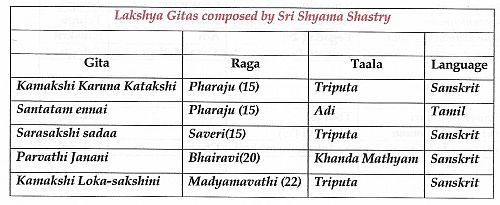









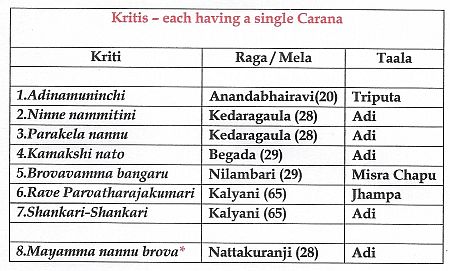 *
*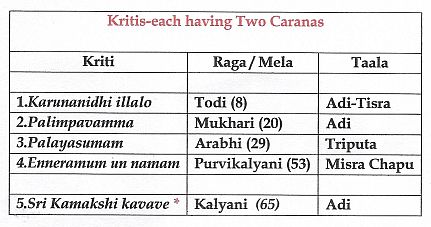

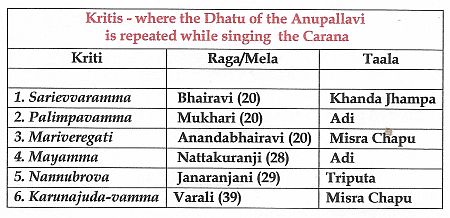














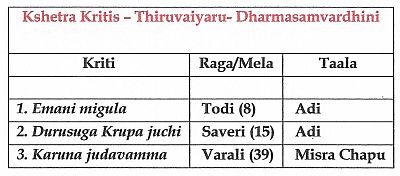




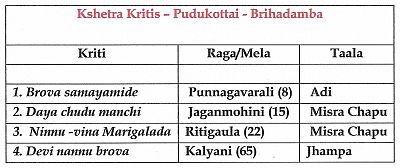
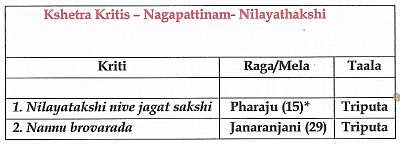



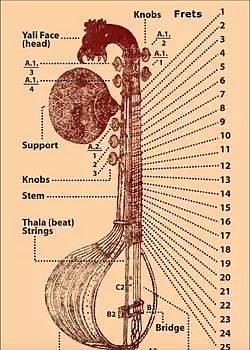



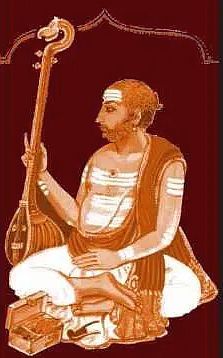








 **
** 
 **
**
 **
**
 **
**





























